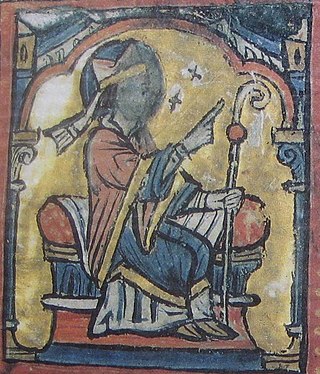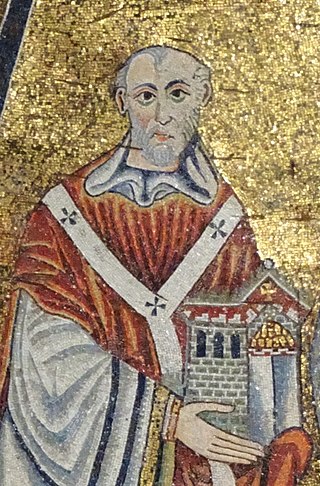Adelardo Cattaneo was an Italian cardinal and bishop. His first name is also listed as Alardo.
Ardoino da Piacenza was an Italian cardinal. His first name is listed also as Arduino.
Ugo Ventimiglia was an Italian cardinal. His name is listed also as Ottone. He was born in Ventimiglia. He was created Cardinal-Bishop of Palestrina by Pope Alexander III in the consistory celebrated in Sens in 1164. Several catalogs of the bishops of Palestrina do not mention him because he does not appear among signatories of any papal bulls issued during his cardinalate.
Pietro da Pavia, Can.Reg. was bishop-elect of Meaux (1171–1175), Cardinal-Priest of S. Crisogono (1173–1179) and finally Cardinal-Bishop of Tusculum. He was papal legate, together with Henri de Marsiac, in southern France against Cathars and Waldenses 1174–1178. He participated in the Third Lateran Council in 1179. Then he was sent again as papal legate to southern France and to Germany. He subscribed the papal bulls issued between October 14, 1173 and July 14, 1182. In 1180 he was elected archbishop of Bourges but it seems that he did not assume that post.

The December 1187 papal election was convoked after the death of Pope Gregory VIII. It resulted in the election of Cardinal Paolo Scolari, who took the name of Clement III.
Imar, O.S.B. Cluny was a French Benedictine abbot, who served as a bishop and cardinal.

The 1130 papal election was convoked after the death of Pope Honorius II and resulted in a double election. Part of the cardinals, led by Cardinal-Chancellor Aymeric de la Chatre, elected Gregorio Papareschi as Pope Innocent II, but the rest of them refused to recognize him and elected Cardinal Pietro Pierleoni, who took the name of Anacletus II. Although Anacletus had the support of the majority of the cardinals, the Catholic Church considers Innocent II as the legitimate Pope, and Anacletus II as Antipope.

Pope Eugene III (1145–1153) created sixteen cardinals in nine consistories:
Pope Lucius II (1144–1145) created eleven cardinals in two consistories.

The 1118 Papal Election was held to choose the successor for Pope Paschal II, who died in Rome on 21 January 1118, after an 18-year pontificate. Pope Gelasius II was elected as his successor. The election happened during the Investiture Controversy, a conflict between supporters of the Papacy and those of the Holy Roman Emperor. The election was held under the threat of possible violence due to the controversy. The Cardinal electors took refuge in the Benedictine monastery, S. Maria in Pallara, during the election. Within minutes of his election as pope, Gelasius II was attacked and imprisoned by the Frangipani faction, supporters of the Holy Roman Emperor. Gelasius managed to escape, but at the emperor's arrival with his army, he fled Rome and never returned.

Pietro Diani was an Italian cardinal. The name "Diana" is incorrect; he signs himself Petrus Dianus.
Benedictus was a Roman Catholic Cardinal, and Cardinal-priest of the titulus of San Pietro in Vincoli in Rome, also called the titulus Eudoxiae.
Saxo de Anagnia was a Roman Catholic Cardinal, and Cardinal-priest of the titulus of S. Stefano al Monte Celio in Rome. He was a native of Anagni, and a member of the family of the Conti di Anagni. Dumas points out that there is no positive evidence of the family connection.
Gregorius was a 12th century Roman Catholic Cardinal, and Cardinal-priest of the titulus of San Lorenzo in Lucina in Rome. A remark by Hugh the Chanter of York appears to indicate that he was a native of Siena. Rudolf Hüls, however, notes that Hugh might have mistaken Gregory of San Lorenzo and Gregory of Santa Prisca. Alfonso Chacón (Ciaconius) calls him Gregorius de Ceccano, a Hernician of the diocese of Aquino. Lorenzo Cardella says that Gregorius was born in Ceccano in the diocese of Sora, "da nobilissima famiglia". There is no evidence whatever that Gregorius of San Lorenzo was a member of the Albergati family of Bologna.

Radulfus Nigellus was a cardinal of the Roman Catholic Church. He was a native of Pisa, or perhaps of France.

Bobo was a cardinal of the Roman Catholic Church. He was a native of Rome, and a member of the Bobone family, later called the Orsini.

Graziano da Pisa was a cardinal of the Roman Catholic Church. He was a native of Pisa, and the nephew of Pope Eugenius III (1145-1153). He had studied law in Bologna, and held the rank of Magister. He was a prominent official in the papal chancery, and an accomplished papal diplomat.

Pietro de Bono was a cardinal of the Roman Catholic Church. He was a native of Verona in Lombardy, signing his name at least once as D. Petri de Verona. He was not from Pisa, nor was he from Bologna. He belonged to the Canons Regular of S. Maria di Reno in Bologna.
The Concordat of 1161 was an agreement between the Kingdom of Hungary and the Papal States, signed by Géza II of Hungary and papal legate Pietro di Miso in late summer or early autumn 1161. The Hungarian monarch squeezed out significant church government concessions for himself in exchange for switching sides and pledging support for Pope Alexander III against the Ghibelline Antipope Victor IV.
This page is based on this
Wikipedia article Text is available under the
CC BY-SA 4.0 license; additional terms may apply.
Images, videos and audio are available under their respective licenses.




